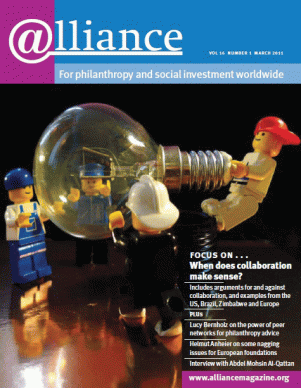The editors of this book have taken on an ambitious task: providing a historical perspective on the impact and significance of the foundation sector in the United States. The book’s various authors give us an excellent inside view on the efforts that foundations have made in different fields of activities.
 For a number of reasons, the book is quite remarkable among the US literature on philanthropy. First, it is not a publication starting from a hero/leader perspective on philanthropy, where an individual philanthropist with his or her vision and entrepreneurship shapes the philanthropic landscape and changes the world for the better. What the book does is underscore the importance of context − socio-political, economic and cultural − and different chapters give a good account of the historical context in which foundations had to – and continue to – work. It also describes the evolution of the fields in which they are working.
For a number of reasons, the book is quite remarkable among the US literature on philanthropy. First, it is not a publication starting from a hero/leader perspective on philanthropy, where an individual philanthropist with his or her vision and entrepreneurship shapes the philanthropic landscape and changes the world for the better. What the book does is underscore the importance of context − socio-political, economic and cultural − and different chapters give a good account of the historical context in which foundations had to – and continue to – work. It also describes the evolution of the fields in which they are working.
This brings me to a second aspect of the book’s distinctiveness. It is not reductionist in the sense that it doesn’t limit its scope, for example, to foundations that are funding scientific research. The editors have made sure that different fields are covered by the different authors: education, healthcare, social welfare, international giving, arts and culture, religion and social movements. This comprehensive approach makes a refreshing change from viewing – and reading about – philanthropy solely through the lens of one particular field.
Third, the book recognizes that our sector needs to be modest because we have significantly less money than other institutions, especially government agencies. So there is no missionary or exaggerated talk in this book, but a realistic description of what foundations can and have achieved and what their limitations are. Fewer pretensions, more ambition is surely a position that realistic practitioners and observers of the sector can endorse.
In short, the book recognizes both the strengths and the challenges of the sector: transparency, the intangible resources of foundations including convening, the need for partnership and the need to embrace the foundation sector’s diversity.
Among the different trends identified in the book it is worth mentioning those to do with impact, measurable results and business models. The book makes it clear that, on many issues, the jury is still out. Social businesses, venture philanthropy and ideas about the so-called outmoded distinction between business and philanthropy will continue to be the subject of a lot of debate for years to come.
It is interesting to note that the editors express some doubts about the often-used logic models of evaluation which apply simple cause-effect reasoning both to the design of programmes and to the measurement of philanthropic impact. It is true that changing the world is not the same as building a house, it is more like raising a child and it is well known that the process in both cases is much more organic than straightforward cause and effect, with many factors and actors involved. Recent articles like the one by John Kania and Mark Kramer in the Stanford Social Innovation Review show that achieving impact is a collective exercise which requires broad cross-sector coordination and in-depth multi-stakeholder management.
In order to get close to measuring – and thus increasing – our real impact, philanthropy needs to look more closely at complexity science theory.
One understandable but unfortunate limitation of the book is its emphasis on grantmaking foundations. The US legal framework makes it difficult for foundations to combine operational and grantmaking work.
Finally, one irritating thing from a non-US perspective is the following amazing claim in the introduction: ‘… in no modern society are foundations more numerous … Compared to their counterparts in Europe and Asia, the philanthropic foundations of the United States look back to a longer and more continuous history’ (pp4-5). Not only is this historical nonsense, but a recent study commissioned by the European Commission showed that European foundations are more numerous and larger in terms of both assets and expenditure than their US counterparts. Of course, it’s not a competition, but it is a pity that such an interesting book should begin with such a US-centred view in this globalized world.
Luc Tayart de Borms is managing director of the King Baudouin Foundation. Email TAYART.L@Kbs-frb.be
American Foundations: Roles and contributions
Helmut Anheier and David Hammack (eds) Brookings Institution Press $64.95
ISBN 9780815703396
To order
http://www.brookings.edu/press/Books/2010/americanfoundations.aspx





Comments (0)